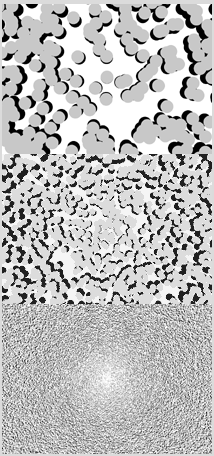Opposition effect mechanism
The Opposition Effect Mechanism: Unveiling the Secrets of Shadows
The opposition effect mechanism is a fascinating phenomenon that occurs in our atmosphere, revealing intriguing insights into the behavior of light and shadows. While the existing content has provided a glimpse into this captivating occurrence, let us delve deeper into the intricacies and complexities surrounding this optical phenomenon.
Shadows Unveiled: Exploring the Opposition Effect Mechanism
-
Shadow Concealment: When objects cast shadows onto a light surface, such as lunar soil grains, earthly rocks, sand, or fir trees, the shadows are often concealed when looking away from the sun. This concealment occurs because the objects themselves hide the shadows, creating an intriguing interplay of light and darkness.
-
Shadow Visibility: As we shift our gaze away from the antisolar point (the point opposite to the sun), the shadows gradually become more visible. This phenomenon can be observed in simulations where objects cast shadows at different magnifications. The increase in shadow visibility away from the antisolar point is due to the changing angle of illumination and the interplay between light and shadow.
-
Brightness in the Antisolar Region: The region opposite to the sun, known as the antisolar region, exhibits a unique characteristic. It appears brighter than its surroundings because it contains fewer shadows and more sunlit surfaces. This discrepancy in brightness arises due to the distribution of light and shadow across the atmospheric landscape.
Exploring Real-Life Examples: From Aircraft Views to Ground Observations
-
Aerial Perspectives: The opposition effect mechanism is often observed from aircraft views over forests, deserts, and even cornfields. When viewed from above, the lower simulations closely resemble the opposition effect experienced in these aerial settings. The interplay between light, shadows, and the landscape creates a mesmerizing spectacle.
-
Ground-level Observations: While primarily observed from elevated viewpoints, the opposition effect can also be witnessed from the ground. Rough road surfaces and dry powdery sand above the high water line of a beach are examples of terrestrial locations where this phenomenon becomes visible. These ground-level observations offer a unique perspective on the interplay between light, shadows, and the surrounding environment.
Unraveling the Complexity: Other Factors Influencing Antisolar Brightenings
-
Retro-Reflection and Crystals: Antisolar brightenings can be influenced by factors other than shadow concealment. Retro-reflection, which occurs when light is reflected back towards its source, can arise from isolated crystals within rocks. These crystals create additional brightening effects, further enriching the complexity of the opposition effect mechanism.
-
Coherent Backscattering: Another factor contributing to antisolar brightenings is coherent backscattering. This phenomenon involves the scattering of light in a specific direction due to its interaction with particles or droplets in the atmosphere. The interplay between coherent backscattering and shadow concealment adds another layer of intricacy to the understanding of the opposition effect mechanism.
-
Atmospheric Moisture and Optical Effects: On Earth, where water droplets are abundant in the atmosphere, additional optical effects such as the heiligenschein and glories come into play. These effects can sometimes be challenging to differentiate from those solely caused by shadow concealment. The presence of atmospheric moisture introduces a complex interplay of light, shadows, and optical phenomena.
The opposition effect mechanism is a captivating optical phenomenon that continues to intrigue scientists and enthusiasts alike. By exploring the concealment and visibility of shadows, as well as the influences of retro-reflection, coherent backscattering, and atmospheric moisture, we gain a deeper understanding of the interplay between light and darkness in our atmosphere. As we continue to unravel the secrets of this mechanism, we uncover new insights into the mesmerizing world of atmospheric optics.

Grey objects casting black shadows onto a light surface.
Simulations at three different magnifications. The objects could be lunar soil grains, earthly rocks, sand or fir trees.
When looking direction away from the sun (the centre of the simulations) shadows are hidden by the objects themselves. Away from the antisolar point they become increasingly visible.
The antisolar region is brighter because it contains less shadow and more sunlit surfaces than its surroundings.
The lower simulations resemble the opposition effect as seen from an aircraft over forests, deserts and even cornfields.
The effect is sometimes visible from the ground - for example, it can be seen on rough road surfaces or in the dry powdery sand above the high water line of a beach.
Antisolar brightenings have other causes. Retro-reflection might also occur from isolated crystals within rocks and there is an effect called coherent backscattereing. On Earth, where there is nearly always plenty of water droplets around, the heiligenschein and glories produce their effects and these are sometimes hard to separate from those made purely by shadow hiding.
Note: this article has been automatically converted from the old site and may not appear as intended. You can find the original article here.
Reference Atmospheric Optics
If you use any of the definitions, information, or data presented on Atmospheric Optics, please copy the link or reference below to properly credit us as the reference source. Thank you!
-
<a href="https://atoptics.co.uk/blog/opposition-effect-mechanism/">Opposition effect mechanism</a>
-
"Opposition effect mechanism". Atmospheric Optics. Accessed on December 22, 2024. https://atoptics.co.uk/blog/opposition-effect-mechanism/.
-
"Opposition effect mechanism". Atmospheric Optics, https://atoptics.co.uk/blog/opposition-effect-mechanism/. Accessed 22 December, 2024
-
Opposition effect mechanism. Atmospheric Optics. Retrieved from https://atoptics.co.uk/blog/opposition-effect-mechanism/.